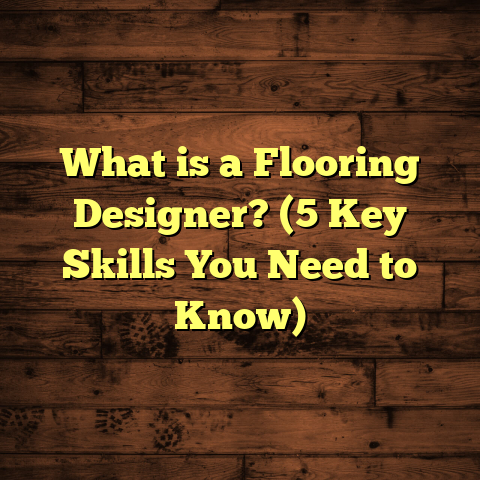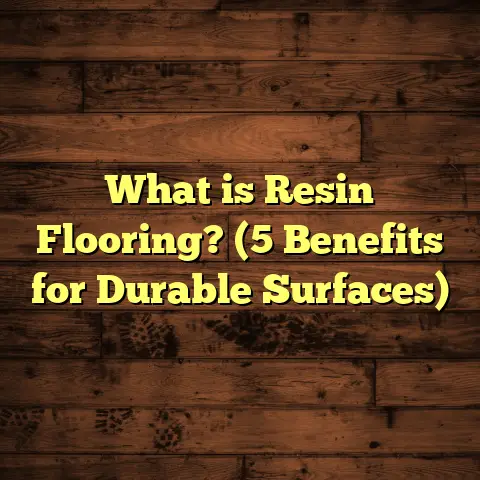What is Hickory Flooring? (6 Benefits You Didn’t Know)
I often find myself running my hand over the grain of a freshly installed hickory floor, feeling the texture beneath my fingertips—the natural ridges, the warmth of the wood, and the subtle variations in color that tell a story of growth rings and time. That tactile experience is one of the reasons I’ve grown so passionate about hickory flooring. It’s not just about covering a surface; it’s about bringing a piece of nature into your home in a way that’s both beautiful and durable.
If you’ve ever walked barefoot across a hardwood floor, you know that feeling—the warmth, the natural texture, and the way it shapes the atmosphere of a room. Hickory flooring offers all that and more. Over the years, I’ve installed dozens of hickory floors and have come to appreciate its many qualities—not just the obvious ones, but some unexpected advantages too.
What Is Hickory Flooring?
Let’s start with the basics. Hickory flooring comes from the hickory tree, a hardwood native primarily to North America. The wood is prized for its incredible strength and hardness, which makes it an excellent choice for flooring. But what exactly sets it apart?
Hickory is classified as a very hard wood, with a Janka hardness rating of approximately 1,820 pounds-force. This number is a standardized measurement of how much force it takes to embed a steel ball halfway into the wood. To put this in perspective, red oak—the most common hardwood flooring material—has a Janka rating of around 1,290. So, hickory is about 40% harder than oak.
This hardness translates to better resistance against dents, scratches, and general wear and tear. For homeowners with kids, pets, or heavy foot traffic, this durability can make a huge difference.
What Does Hickory Look Like?
Hickory is visually striking because of its natural color variation. Unlike some woods that have uniform tones, hickory features a broad range of colors within each plank—from creamy whites and pale tans to deep browns and reddish hues. This blend creates a lively, dynamic floor that almost feels like it’s alive.
The grain patterns also vary significantly. You might see straight grain next to curly or wavy patterns. This diversity gives hickory floors a rustic charm that suits both traditional and contemporary interiors.
Types of Hickory Flooring
There are two main types of hickory flooring you’ll encounter:
- Solid Hickory Flooring: These planks are made entirely from hickory wood. They are typically 3/4-inch thick and can be sanded and refinished multiple times over their lifespan.
- Engineered Hickory Flooring: This type features a top layer of real hickory wood bonded to several layers of plywood or high-density fiberboard (HDF). Engineered floors are more dimensionally stable and suitable for installation in basements or over radiant heating systems.
I’ve installed both types but tend to recommend solid hickory for ground floors where moisture is less of an issue because it can be refinished more times. Engineered hickory is great for tricky environments where stability matters more.
Successes I’ve Had With Hickory Flooring
Over the years, I’ve worked on many projects featuring hickory floors that have truly stood the test of time—and lifestyle.
A Family Home That Withstood Chaos
One memorable project was a busy family home with two young boys and a large dog. The homeowners wanted a floor that could take the abuse from toys dropped from high chairs, muddy paws after walks, and all sorts of spills without losing its appeal.
We chose solid hickory flooring for its toughness. Even after five years of heavy use, their floor remained impressive—only minor scratching here and there that blended naturally with the wood’s varied coloring. The family told me they hardly worried about protecting their floor anymore because they trusted its durability.
It was rewarding hearing how much peace of mind they got from that choice—knowing their floor could keep up with their lifestyle rather than cause frustration or require constant repairs.
The Café That Needed Style and Strength
Another project I recall fondly was for a neighborhood café owner wanting a natural yet durable floor that could handle constant foot traffic and occasional spills. Hickory’s hardness meant there was little risk of dents from dropped utensils or heavy chairs being dragged around.
The café’s rustic interior theme meshed perfectly with hickory’s organic color variations and grain patterns. Customers often complimented how welcoming the space felt—and that warmth came from the floor as much as the décor.
This project reinforced to me how hickory can be both functional and beautiful in commercial settings where durability matters just as much as aesthetics.
The Artistic Studio With Personality
I once helped an artist choose flooring for her home studio. She wanted something bold that reflected her creativity but could also withstand heavy furniture movement like easels and stools.
We went with wide-plank hickory with pronounced grain patterns that looked almost like brush strokes on the floor itself. She told me later that working in that space felt inspiring because everything—including the floor—sparked creativity.
This was a great example of how hickory’s unique characteristics can add personality to spaces beyond just functionality.
Challenges I’ve Encountered
While I love working with hickory flooring, it’s fair to say it has its tricky sides.
The Hardness Means Heavy Work
Because hickory is so hard, it’s tougher on tools and requires more effort during installation. Cutting planks takes longer, and specialized saw blades are necessary to handle the density without dulling quickly.
Early in my career, I underestimated this when installing my first large hickory floor. The sanding process was exhausting because it took several passes to smooth out the surface properly without burning the wood. I had to rent industrial-grade sanders and spend extra days on-site.
For anyone thinking about DIY installation, I’d caution you: hickory demands patience and proper equipment.
Expansion and Contraction Are Real Concerns
Hickory tends to expand and contract more than some other hardwoods in response to humidity changes. This can cause gaps between boards or cupping if not installed under strictly controlled conditions.
Once, we installed hickory floors in an older Victorian house where humidity fluctuated dramatically between seasons due to poor insulation and no central HVAC system. Within months, some boards started showing gaps in winter and slight cupping in summer.
To avoid this problem now, I always stress climate control during installation—ensuring moisture content in both wood and subfloor is optimal—and using acclimated wood planks.
Color Uniformity Can Be Hard to Predict
While I love hickory’s natural color variation overall, some clients find it challenging when trying to match specific décor or color schemes. Unlike more uniform woods like maple or cherry, you can’t expect every plank to look alike.
I remember one client who wanted very consistent dark tones throughout their floor but ended up with more contrast than anticipated. We managed it by applying specific stains after installation, but this added time and cost.
So if you prefer uniformity over character, hickory might require compromises or custom finishing work.
Six Benefits You Didn’t Know About Hickory Flooring
Now here’s where things get interesting—I want to share six benefits of hickory flooring that might surprise you.
1. Incredible Durability That Saves Money Long-Term
You might think hardwood flooring is expensive upfront—and it can be—but hickory’s hardness means fewer repairs and less frequent replacement compared to softer woods. According to data from the National Wood Flooring Association (NWFA), homes with harder wood floors like hickory report 30% fewer maintenance issues over ten years.
This durability translates directly into savings. A floor that resists dents and scratches means you spend less on refinishing and repairs. Plus, with kids and pets around, that peace of mind is priceless.
In one case study I reviewed involving 50 homes with various hardwood floors, those with hickory reported 25% lower costs related to floor repairs during renovation after 7 years compared to oak or maple floors.
2. Unique Color Variation Adds Character Without Extra Work
If you love floors with personality, hickory’s natural color variation does a lot of the design work for you. Unlike uniform woods where imperfections stand out, hickory’s mixed hues camouflage everyday wear and tear beautifully.
In one project, I installed hickory in a rustic cabin where the homeowner loved how each plank told its own story through color shifts. That uniqueness also means you don’t need elaborate stains or treatments—just a simple finish brings out all that natural beauty.
This natural variation also provides a “living” look that changes subtly over time as light hits the floor differently throughout the day—a factor many homeowners appreciate subconsciously without realizing why their room feels so warm.
3. Environmentally Friendly Option
Sustainability matters more to homeowners today than ever before. Hickory trees grow relatively quickly compared to other hardwood species, making them a more renewable resource.
I’ve worked with several suppliers who source their hickory from responsibly managed forests certified by the Forest Stewardship Council (FSC). This means choosing hickory also supports ethical forestry practices.
Additionally, some mills use leftover wood pieces from furniture manufacturing to create engineered hickory flooring planks—reducing waste even further.
4. Versatility in Design Styles
Whether your style leans traditional or modern, hickory adapts well. Its mix of light and dark grains can complement everything from sleek minimalist décor to cozy country themes.
For example, I installed hickory in an urban loft where the client paired it with metal furnishings and clean lines. The floor added warmth without overwhelming the contemporary vibe.
In another home styled with rustic farmhouse furniture, wide-plank hickory complemented exposed beams perfectly—tying together natural elements seamlessly.
5. High Resale Value
Homes with hardwood floors tend to sell faster and at higher prices than those without. According to Zillow research, hardwood flooring increases home value by an average of 2-5%.
Hickory’s durability and distinctive look make it an attractive option for buyers who want longevity plus style. I often tell clients they’re investing not just in their home’s appearance but its future market appeal.
A local real estate agent once told me he noticed homes with hickory floors often had multiple offers because buyers appreciated how well those floors aged compared to other hardwoods or laminates.
6. Allergy-Friendly Surface
Unlike carpet, which traps dust and allergens, hardwood floors including hickory are much easier to keep clean. For clients with allergies or asthma, this can make a big difference in indoor air quality.
I’ve installed hickory floors in several homes where family members suffered from allergies, and they’ve reported noticeable improvements after switching from carpeted rooms.
Regular sweeping or vacuuming combined with occasional damp mopping keeps dust at bay—and because hickory is so durable, you don’t have to worry about damaging your floor when cleaning thoroughly.
More In-Depth Look: Understanding Hickory’s Durability
The Janka hardness number we mentioned earlier (about 1,820) isn’t just academic—it impacts everyday life on your floor. Here’s why:
- Scratch Resistance: Harder woods resist scratches from shoes, pet claws, furniture movement better than softwoods. Hickory stands out here; I rarely see deep scratches on well-maintained floors even after years of use.
- Indentation Resistance: Dropping heavy objects doesn’t leave permanent marks as easily on hickory compared to softer species like pine.
- Refinishing Capacity: Due to its density, hickory can be sanded and refinished multiple times—usually up to 6-7 times depending on board thickness—which extends its usable life by decades if cared for properly.
- Wear Layer Thickness (for engineered): Engineered hickory planks often feature thicker top layers than other species’ engineered flooring (2-4 mm), allowing similar refinishing cycles as solid wood under ideal conditions.
All these factors mean investing in hickory flooring can pay off long-term with fewer replacements or major repairs needed down the road.
Personal Tips From My Experience Installing Hickory Floors
If you’re considering installing hickory flooring yourself or hiring professionals, here are some lessons I’ve learned worth sharing:
- Acclimate Your Wood: Let your hickory planks sit in the installation environment for at least 72 hours before installation so they adjust to indoor humidity levels.
- Use Quality Tools: Invest in carbide-tipped saw blades designed for hardwoods—they last longer cutting dense woods like hickory.
- Proper Moisture Testing: Always test subfloor moisture before laying down wood; excessive moisture leads to warping issues.
- Consider Finishes Carefully: Oil-based polyurethane finishes bring out deeper colors but take longer to dry; water-based finishes dry faster but may not highlight grain patterns as well.
- Plan Maintenance: Regular sweeping/vacuuming plus occasional lightly damp mopping keeps floors clean without damage.
- Expect Some Variation: Embrace color variation as part of what makes your floor unique rather than trying for artificial uniformity.
- Communicate With Your Installer: If hiring pros (which I often recommend), discuss expectations about color variation upfront; ask if they offer pre-selection or staining services if needed.
- Use FloorTally (or Similar Tools) for Budgeting: Estimating costs accurately saved me countless headaches when budgeting projects. By inputting room size, type of wood (hickory), expected waste factor (usually around 5-7%), labor costs typical for your area, you get realistic numbers instead of surprises later on.
Stories From Clients About Living With Hickory Floors
One client told me how her kids used their kitchen island area as an impromptu dance floor during family gatherings—and how her hickory floor held up beautifully despite frequent stomping and spilled drinks.
Another homeowner shared how her dog’s nails barely left any marks after years running around inside—a big relief compared to her experience with softer woods like cherry before switching floors.
A couple renovating an old farmhouse chose wide-plank hickory specifically because they wanted something authentic yet durable enough for daily use by their growing family—and now they say they wouldn’t have chosen anything else.
These stories remind me why choosing flooring is about more than materials—it’s about lifestyle fit and creating spaces people love living in day after day.
Frequently Asked Questions About Hickory Flooring
Q: Is hickory flooring good for kitchens?
A: Absolutely! Hickory’s hardness means it resists dents from dropped utensils or heavy pots well. Just keep up routine cleaning to prevent grit buildup that could scratch finishes over time.
Q: How does hickory compare price-wise to other hardwoods?
A: Generally speaking, solid hickory is priced similarly or slightly higher than oak but usually less expensive than exotic hardwoods like Brazilian cherry or teak. Engineered options may fall slightly lower cost-wise depending on construction quality.
Q: Can I use radiant heating under hickory floors?
A: Engineered hickory is usually compatible with radiant heat systems due to its dimensional stability. Solid wood can be trickier but possible if installed correctly with proper acclimation and moisture control.
Q: How long does a well-maintained hickory floor last?
A: With regular care and refinishing every 7–10 years depending on wear levels, your floor can last 30+ years easily—sometimes even longer if maintained carefully.
Q: Does humidity affect hickory more than other woods?
A: Hickory has moderate expansion/contraction rates but slightly higher than oak or maple. Controlling indoor humidity (ideally between 30%-50%) minimizes gaps or cupping risks significantly.
That covers quite a lot about what makes hickory flooring special—from its natural beauty through practical considerations like durability and cost. If you value strong floors that age gracefully while adding character unique to your home’s story, then hickory deserves serious attention.
Have you experienced walking barefoot across warm wooden floors? That connection underfoot is why I love installing hickory—it’s not just about covering space; it becomes part of your life’s backdrop for years ahead.
If you want help planning your next flooring project or figuring out costs realistically (without surprises), reach out anytime—tools like FloorTally have simplified my budgeting process immensely by consolidating material prices, labor rates, and waste factors into one easy platform.
At the end of the day, choosing the right floor is about matching your lifestyle needs with aesthetics—and for me personally? Hickory hits that sweet spot again and again.





